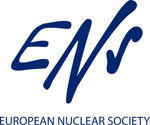Nuclear in the energy mix
There are strong economic and environmental arguments
for building more nuclear power plants in Europe and other regions of
the world.
There are more than 140 power reactors in the European Union, producing
around 28% of all the Community’s electricity. Nuclear is one of the
EU’s largest single energy source for power generation, closely of coal at 29% and ahead of gas at 23%.
The power plants operate safely and reliably, producing large amounts
of electricity at competitive prices. They are environmentally friendly,
as they emit no greenhouse or acid rain gases and their waste is safely
managed.
The nuclear industry thereby makes a valuable contribution towards achieving
Europe's economic, energy supply and environmental objectives.
The nuclear energy option should be kept open and nuclear expertise
should be retained, in order to:
-
achieve a viable and diverse energy mix
-
control airborne pollution and hold down emissions of CO2–
the main greenhouse gas
-
maintain security of energy supply and energy independence
-
promote economic development and employment.
EU Power shares 2007
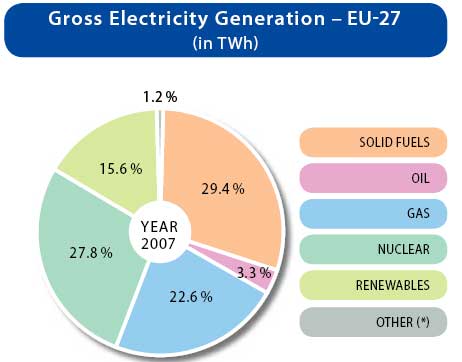
Source DG TREN pocketbook 2010
1. Economics
Each country needs an appropriate energy strategy,
reflecting its natural resources and its energy needs. Nuclear energy
enables countries to:
-
reduce their reliance on imported fossil fuels and electricity
imports
-
increase their energy independence
-
strengthen security of energy supply.
With greater reliance on nuclear energy, countries are less likely to
be seriously affected by fossil fuel shortages and sudden rises in fossil
fuel prices.
Any future decline in nuclear’s contribution to EU energy supply
will have serious implications for the region’s economy and environment.
Phase-out policies have been pursued by certain West European coalition
governments for reasons that are purely political and ideological. The
political decisions involved have not been based on safety, environmental
or economic arguments, and have been out of line with public opinion,
according to poll results.
For the generation of bulk electricity, nuclear remains the only non-fossil
energy source capable of expansion within Europe in the foreseeable
future. The potential for expanding large-scale hydro is extremely limited,
and nuclear fusion is still a long way off.
Wind farms and solar can play a supporting role, but the amount of power
these sources can provide is extremely low compared to nuclear. They
are also dependent on changeable factors, such as wind strength and
sunshine. This makes them unsuitable for baseload generation, the power
needed round-the-clock, day and night. Nuclear power plants, meanwhile,
are an excellent source of baseload power.
The earth’s fossil resources are finite and should be preserved
as much as possible, as they have important industrial uses other than
power generation. Europe is heavily dependent on the Middle East and
Russia for its oil and gas supplies, and political instability in certain
regions could lead, at any time, to supply shortages and price rises.
On the other hand, the uranium used in nuclear fuel is available from
various countries with a long history of political stability, including
Australia and Canada. This has a stabilising effect on uranium prices
and supply. Any rise in uranium prices would have only a minor impact
on the cost of a nuclear kilowatt-hour, as fuel makes up a comparatively
small part of the total cost of producing nuclear electricity. Power
plants that burn fossil fuels are more fuel-intensive; producers and
consumers therefore face a much greater risk of increased costs due
to higher fuel prices.
Many existing nuclear power plants have already been paid for. Their
operating costs are therefore low, and the electricity produced is among
the cheapest in comparison with other sources. Cost projections show
that new power reactors will also be competitive, even assuming low
gas prices and heavy subsidies for wind power.
Cost comparison: nuclear, gas and wind power in the EU
Technology |
Operating hours |
€ per MWh |
Nuclear |
8000 hours/year |
35,0 |
Peat |
43,6 |
Coal |
45,7 |
Gas |
51,2 |
Wood |
73,6 |
Wind |
2200 hours/year |
52,9 |
Source: Lappeenranta University of Technology, Finland, January 2008;
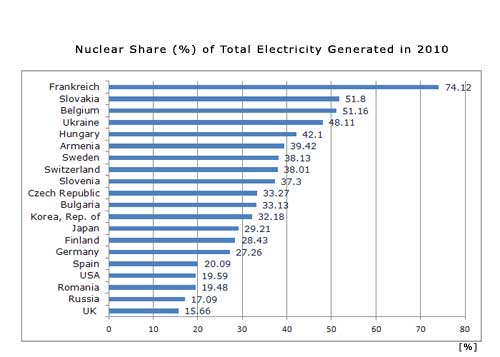
Source: International Atomic Energy Agency
2. Environment
More than 2 billion people world-wide have no access
to electricity. This figure represents about one-third of the world’s
population.
World energy demand will continue to grow as populations increase and
countries undergo industrial development and economic expansion.
To meet these increasing demands, and to improve living standards for
future generations, large increases in electricity generation will be
necessary. Such increases must be achieved in a sustainable way that
has the lowest possible environmental impact.
However, nuclear may not be an ideal energy option in every part of
the world, as certain regions have no power transmission network. In
addition, investment in nuclear may not be justified in areas where
electricity demand is low.
Nuclear power plants generate about 17% of the world’s electricity
and thereby avoid each year the release of some 1.8 billion tonnes of
CO2world-wide.
In Europe alone, climate-friendly nuclear electricity saves the emission
of about 500 million tonnes of CO2 a year. To make an equivalent
saving by reducing car use, the amount of motoring done in the EU would
have to drop by 75%.
CO2 emissions can be further avoided by building new power
reactors, upgrading existing nuclear plants to increase output and by
extending plant operating lifetimes.
All forms of energy, including nuclear, will be needed in the ongoing
quest for sustainable development. Specific options aimed at long-term
solutions should not be excluded because of short-term political pressures.
Many of Europe’s nuclear plants will reach retirement age in the
next 20 years. Atmospheric pollution and CO2emissions will
surge, if the reactors are replaced by power plants that burn fossil
fuels.
No single energy source can be ‘sustainable’ by itself.
However, nuclear can contribute to creating a sustainable energy system
and thereby to sustainable development.
Alternatives
Solar
Installing solar cells to replace a nuclear power plant
(cost €2.56 billion) would require an investment of around €92
billion. The cells involved would cover 150 square kilometres, a surface
equivalent to the whole of the Brussels urban area within the city's
ring road.
Wind
If you replaced all the EU’s nuclear plants with
wind turbines, they would cover an area of 32,000 square kilometres.
Here, the equivalent would be a ten kilometre-wide coastal area stretching
from the northernmost point in Denmark, right around France, to the
north-west tip of Spain.
Nuclear Power Reactors in Europe, 2011
Nuclear Power Reactors in Europe |
| Country |
Number
of Sites |
Number
of Units |
Units
under construction |
Capacity
(MWe) |
Nuclear
Share (2002) |
Belgium |
|
|
- |
|
|
Bulgaria |
|
|
2 |
|
|
Czech
Republic |
|
|
- |
|
|
Finland |
|
|
1 |
|
|
France |
|
|
|
|
|
Germany |
|
|
- |
|
|
Hungary |
|
|
- |
|
|
Netherlands |
|
|
|
|
|
Romania |
|
|
|
|
|
Russian Federation |
11 |
32
(5 in Aia) |
11 |
22,693 |
17% |
Slovak
Republic |
|
|
|
|
|
Slovenia |
|
|
|
|
|
Spain |
|
|
- |
|
|
Sweden |
|
|
- |
|
|
Switzerland |
|
|
|
|
|
Ukraine |
4 |
15 |
2 |
13,107 |
48% |
UK |
|
|
- |
|
|
Overall
Total |
|
|
|
|
|
Source: International Atomic Energy Agency
3. Safety
The nuclear industry in Europe is strictly regulated
and enjoys an excellent safety record – something the plant owners
and operators are determined to maintain. Safety is the industry's top
priority.
This safety record has been achieved by high standards applied to the
design, maintenance, and operation of nuclear installations –
power stations, nuclear fuel manufacturing and reprocessing plants and
installations for the processing and storage of radioactive waste. Research
and development work has also played an important role in this area.
Transport
-
The transport of radioactive materials is carried
out under strict regulatory controls, and an excellent safety record
has been maintained in this highly specialised field. The highest
possible safety standards, covering all modes of transport, are
enforced at all times, in accordance with internationally agreed
requirements.
-
Since the start of the nuclear industrial era
some 40 years ago, there has never been a transport accident resulting
in the injury or death of an individual as a result of the radioactive
nature of the cargo. Nor has there ever been any impact on public
health or the environment.
-
There are more than 10 million transports of radioactive
material around the world each year. Most involve packages containing
radioisotopes used in medicine, industry, agriculture or scientific
research.
-
In the past 40 years, about 30,000 tonnes of spent
nuclear fuel have been transported safely around the world, across
distances totalling more than 25 million kilometres – by road,
rail and sea.
-
Regulations applied to the transport of radioactive
materials are designed to ensure that the risks to public health
and the environment are negligible. The prime objective is to protect
people, property and the environment against the direct and indirect
effects of radiation during transportation.
Decommissioning
Techniques are already in use for the safe decommissioning
of nuclear facilities and the restoration of nuclear sites.
Actual decommissioning costs are turning out to be lower than originally
predicted, thanks to technological advances and to the accumulation
and sharing of technical know-how and data.
The European nuclear industry includes companies that are world leaders
in the huge global market for plant decommissioning and site restoration.
EU Enlargement
Nuclear safety is of fundamental importance world-wide,
but concerns about it should not be stimulated without foundation, nor
used in a purely political context to prevent or delay the accession
of countries wishing to join the European Union.
The current principles covering the accession issue date back to a time
when the 1986 Chernobyl accident was still fresh in people's minds.
New guidelines are needed to take account of the considerable progress
made in improving the safety of Russian-design reactors. A great deal
of Western assistance has gone into achieving these improvements.
Discussions about the use of nuclear power in the accession states should
focus primarily on the current status of safety at the plants concerned.
At the same time, policy-makers should fully recognise the right of
sovereign nations to determine their own energy options.
4. Waste Management
The amount of radioactive waste generated annually
by nuclear power plants is small in comparison with the total volume
of waste produced by modern industrialised society.
Nuclear plant operators set aside part of the cost per kilowatt-hour
to finance not only plant decommissioning but also the safe management
and isolation of the industry’s waste. Within the power generation
sector as a whole, the nuclear energy industry is unique in this respect.
Proven technologies and strict regulations exist for managing radioactive
wastes in ways that are safe, economical and environmentally sound.
Considerable experience exists with these technologies in many countries.
Radioactive waste can be stored safely in a monitored and retrievable
form for a very long time.
Universally, the overriding objective is to manage the waste in such
as way as to protect human health and the environment and to limit any
burden on future generations. Waste is processed into a solid form and
is encased in special containers, before being placed in a facility
on or near the surface or below ground. Natural and engineered barriers
are used to isolate the waste from the biosphere.
World-wide there are many disposal concepts for spent nuclear fuel and
for the high-level radioactive waste left over after the reprocessing
(recycling) of spent nuclear fuel. So far, no great urgency has been
necessary because of the safety of existing facilities that store this
material on an interim basis. Disposal deep underground is emerging
internationally as a preferred option.
The basic technology and financing mechanisms are already in place for
the construction of deep underground repositories. Building up political
consensus and public acceptance should now be the top priority, in order
to achieve further progress in this area. Significant progress is already
being made in Finland, Sweden and the US.
A majority of Europeans believe the present generation should take responsibility
for its radioactive waste, according to the results of an EU-wide poll
published in 2002 by the European Commission.* The present generation
has derived enormous benefits from nuclear technology, and is duty bound
to permanently resolve this important environmental issue.
When is waste not waste?
When nuclear fuel is removed from a reactor after being
used, it can follow one of two distinct routes. Government policy may
dictate that it should be disposed of. In this case, it is classed as
waste. Alternatively, the power company involved may be in a position
to have the spent fuel reprocessed. In this case, it is considered a
valuable energy resource destined for recycling.
Reprocessing, carried out by two major companies, BNFL in the UK and
Cogema in France, results in the recovery of 97% of the reusable material
inside the spent fuel. This is made up of uranium and plutonium, and
both can be used in the production of mixed oxide (MOX) fuel. The remaining
3% is highly radioactive waste which is immobilised in glass –
a process called vitrification – and encased in special containers
for long-term storage in purpose-built facilities. At a later stage,
the vitrified waste can be disposed of in deep underground repositories,
in the same way as spent fuel that has not been reprocessed.
|
|
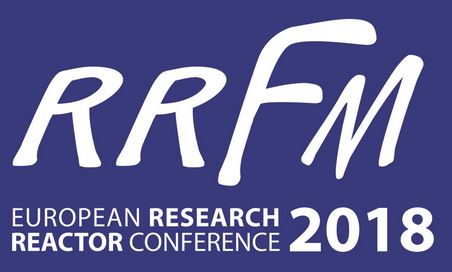
11 - 15 March 2018
Munich, Germany
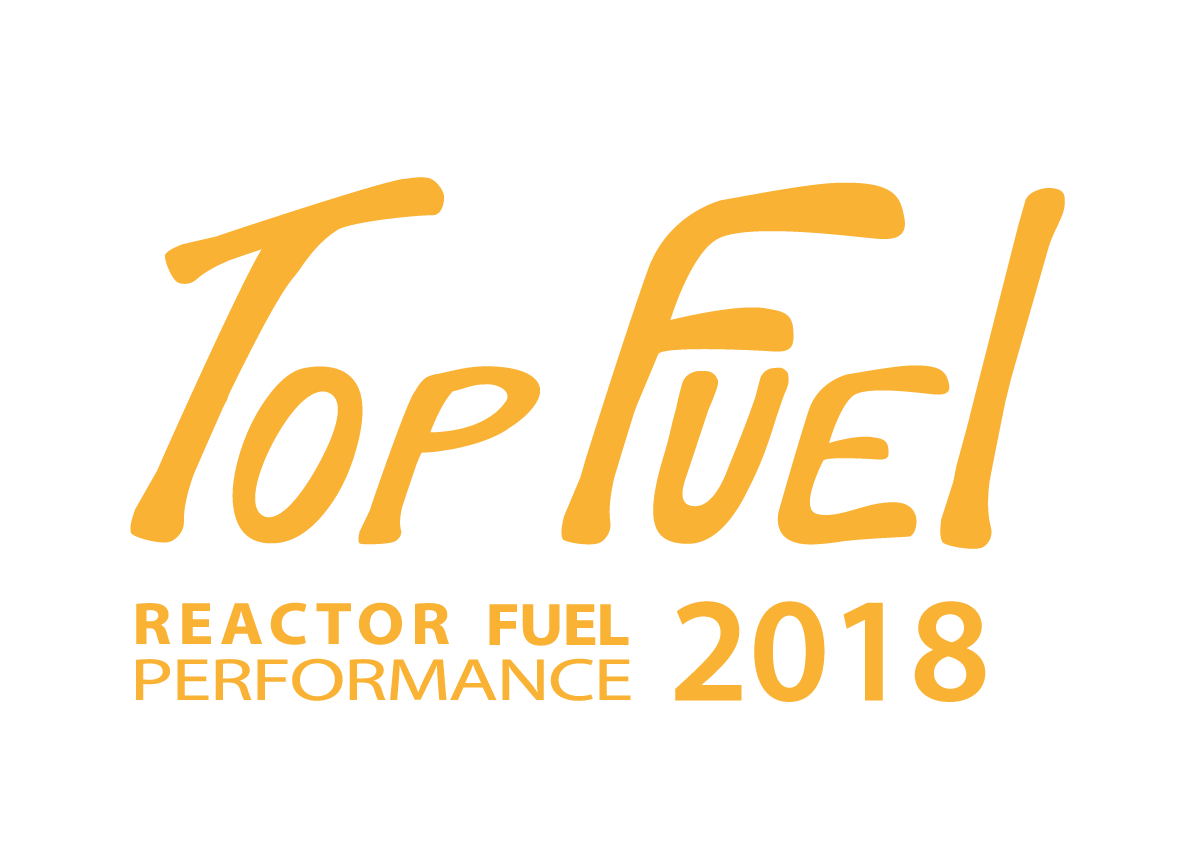
30 September - 04 October 2018
Prague, Czech Republic |
